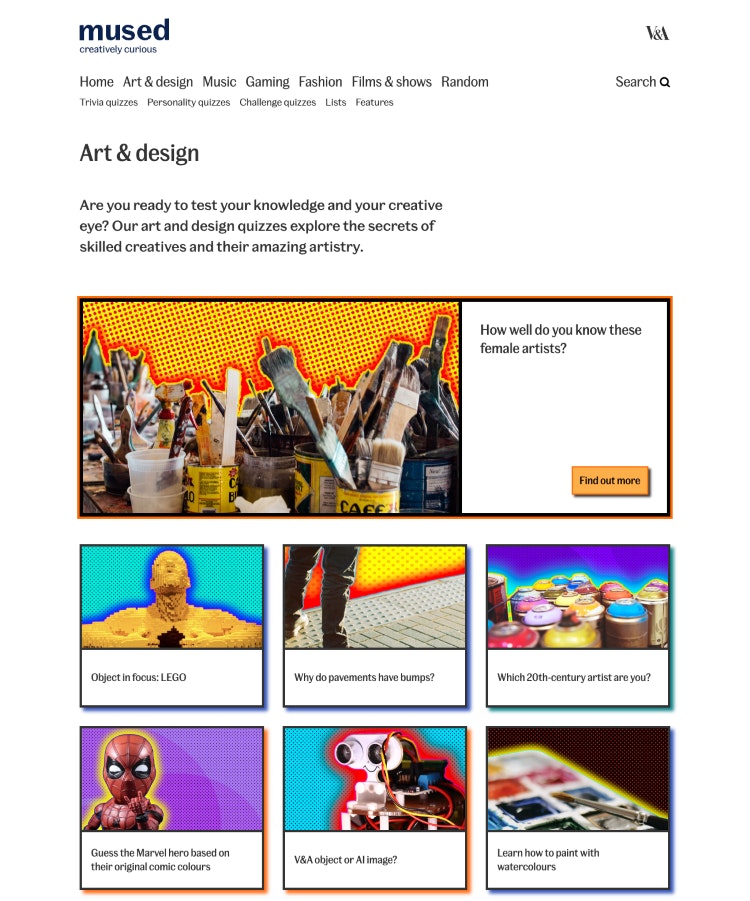The V&A has launched Mused, a new interactive website, supported by Bloomberg Philanthropies’ Digital Accelerator for Arts and Culture, in a bid to engage young people in art, design, performance and creativity.
It comes during a “period of transformation” for the cultural institution, with the opening of Young V&A and its two East London sites, as it looks to “reach new audience in new ways”, says V&A head of experience and digital media Kati Price. The site is aimed at Generation Alpha – a term used to describe the generation of people born (or who will be born) between 2010 and 2025 – with a particular focus on 10–14-year-olds.

After researching existing platforms for young people, Price found that 10–14-year-olds were “underserved in terms of a cultural offer online”, which is why the V&A chose to focus on this age group. Despite this, following its soft launch a few months ago, referral traffic data has shown that a broad age range has engaged with the site, including older teens and adults, so there seems to be “a broader appeal”, according to Price.
Across its core categories of art and design, fashion, music, film and TV, gaming, and the audience-inspired ‘random’ category, Mused has over 100 quizzes, challenges and articles. This includes personality quizzes, like Which fashion ‘core’ is your style? and Which British fashion house should you live in?, and knowledge-testing trivia quizzes, such as Can you match the colours to the Marvel movie? and V&A object or AI image?.

Hidden learning opportunities are dotted between the questions in the form of facts about the creative process, included to inspire further exploration and curiosity around art, design and creativity. The platform aims to give young people “social currency” by way of “having things to talk about on the playground” with confidence, says Price.
Her hope is that Mused taps into their existing interests while introducing them to new topics, which she can already see evidence of from user testing. User labs revealed that, while some might start with a personality quiz or a popular music quiz, they then move to other topics that they might know less about, according to Price.
While museums and other cultural institutions typically use their collections and galleries as a starting point for digital content, Price says the V&A has “flipped that on its head”, looking at what its audience’s interests are and how the V&A can “show up digitally to meet those needs and interests”. Price reveals that user content is informed by a Trendspotter panel, which is a group of diverse young people who helped identify “key trends and themes” in how the target audience consumes content and if there are links to what the V&A exhibits.

Regular user testing sessions through user labs also helped identify features and content for the website that most appeal to the target audience of 10–14-year-olds. From these labs there were many discussions around the editorial process. Price explains how the V&A team had to consider “making an editorial choice on what the most relevant and safe topics are” rather than “just following whatever kids are talking about”.
Taking a “safety first approach”, Price says the V&A designed the website to highest accessibility and child safety standards, according to the ICO children’s code and in accordance with GDPR and COPPA rules around safeguarding children online.
Price notes that V&A’s main goal was for “kids to have their own experience with lots of agency” as they interact with Mused at home, while parents and carers can be confident that it is safe. Speaking with the V&A learning teams as well as teachers, Price found that “there is definitely a potential role for it in the classroom, particularly with the need for more focus on learning about art and design in schools”.
Ultimately, “online engagement is the end goal” for Mused, but Price hopes that, with links to exhibition programming featured on the site, young people will also want to visit the physical sites.

- Design disciplines in this article
- Brands in this article










